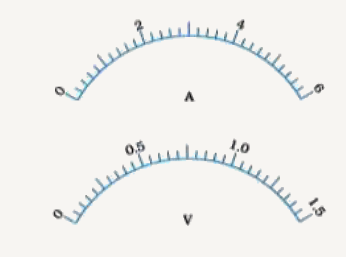What is an ammeter ? Solution in Punjabi
Ammeter : It is a low resistance instrument used to measure electric current in a circuit. An ideal ammeter should have zero resistance. It is always connected in series in an electrical circuit.
Conversion of galvanometer into an ammeter : Consider a galvanometer of resistance G. It can be converted into an ammeter by connecting a low resistance called shunt (S) in series with it.
The value of shunt depends upon the range of current to be measured.
Suppose we want to convert a galvanometer into an ammeter of range0−Iampere.
Ig= Maximum current that can pass through the galvanometer.
n = Number of divisions in the galvanometer scale
k = Figure of merit (or current for deflection of the one division in the galvanometer)
∴Ig=nk
the value of S is so adjusted that out of maximum current I, only a part Ig should flow through the galvanometer and the remaining (I−Ig) flows through the shunt.
As G and S are connected in parallel with each other, so
So VA−VB=IgG=(I−Ig)S
S=(IgI−Ig)G
Thus, s can be determined.
So by connecting shunt resistance of suitable value in series with a galvanometer, we can get an ammeter of range 0−I ampere.
Voltmeter : It is a high resistance instrument which is used to measure potential difference across the two points in a circuit.
Resistance of an ideal voltmeter is infinite.
Voltmeter is always connected in parallel in an electrical circuit.
Conversion of galvanometer into a voltmeter : Consider a galvanometer of resistance G.We want to convert it into a voltmeter of range 0 to V volt.

It can be done by connecting a high resistance R in parallel withe the galvanometer.
The value of R depends upon the range of voltage to be measured.
Let Ig= Current that gives full scale deflection in galvanometer.
n = Number of divisions in the galvanometer scale
k = Figure of merit
∴Ig=nk.
The value of R is connected in series with the galvanometer so that a current Igflows through the galvanometer when a potential difference V is applied across the points A and B.
As G and R are connected in series, so
V=Ig(G+R) (By Ohm.s law)
G+R=VIg
If a resistance of the value given by above eqn. is connected in series with the galvanometer, it will work as a voltmeter of the range (0−V) volt.

Topper's Solved these Questions
- FORCE ON A CURRENTBOOK - BETTER CHOICE PUBLICATIONCHAPTER - FORCE ON A CURRENTEXERCISE - SHORT ANSWER TYPE QUESTIONS (MOST EXPECTED QUESTIONS)
5 Videos
- FORCE ON A CURRENTBOOK - BETTER CHOICE PUBLICATIONCHAPTER - FORCE ON A CURRENTEXERCISE - LONG ANSWER TYPE QUESTIONS
15 Videos
- FORCE ON A CURRENTBOOK - BETTER CHOICE PUBLICATIONCHAPTER - FORCE ON A CURRENTEXERCISE - VERY SHORT ANSWER TYPE QUESTIONS (MOST EXPECTED QUESTIONS )
5 Videos
- FORCE ON A CHARGE BOOK - BETTER CHOICE PUBLICATIONCHAPTER - FORCE ON A CHARGE EXERCISE - NUMERICAL PROBLEMS
14 Videos
- GAUSS'S THEOREMBOOK - BETTER CHOICE PUBLICATIONCHAPTER - GAUSS'S THEOREMEXERCISE - MOST EXPECTED NUMERICALS
4 Videos
Similar Questions
What is a safety fuse? Explain its function.
View SolutionState the principle of moving coil galvanometer?
View SolutionDefine an ampere in terms of the force between current carrying conductors.
View SolutionAn electron (with charge 1.6×10−19C) moving at right angles to a uniform magnetic field completes a circular orbit in 10−6sec. Calculate the vlaue of magnetic field. Given mass of electron =9×10−31kg.
View SolutionA box encloses an electric dipole of 3μCand−3C, if the dipole length is 6 cm, then find total electric flux associated with box.
View SolutionWhat is the resistance of an ammeter ?
View Solutionआदर्श अमीटर का प्रतिरोध कितना होता है
View SolutionWhat is the resistance of an ideal ammeter?
View Solutionवोल्टमीटर व अमीटर से क्या तात्पर्य है?
View Solutionअमीटर का प्रतिरोध कितना होता है ?
View Solutionwhat is ammeter?
View SolutionWhat is use of Ammeter in circuit.
View SolutionWhat is resistance of ideal ammeter.
View SolutionThe scales of an ammeter and a voltmeter are shown below:

What is the range of the ammeter and the range of the voltmeter?
View SolutionWhat is the resistance of ideal ammeter.
View Solution
